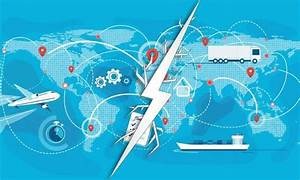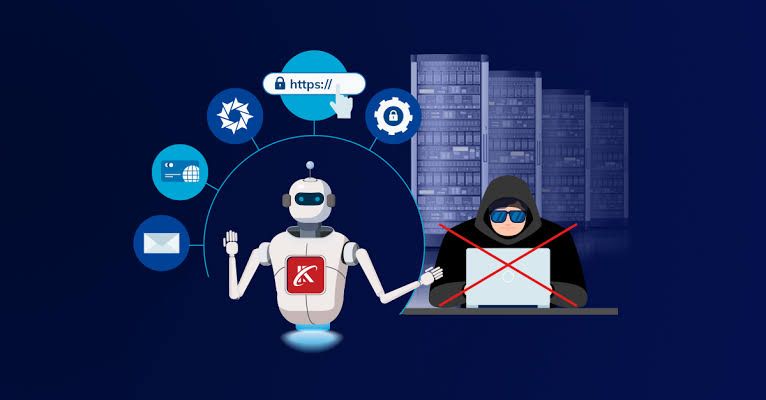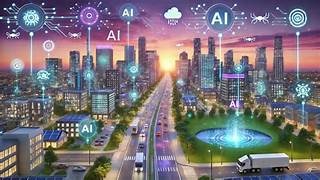
AI for supply chain resilience: predicting disruptions (climate, geopolitical), optimizing alternatives.
Artificial Intelligence (AI) is revolutionizing supply chain management by predicting disruptions caused by climate change, geopolitical instability, and unexpected events. By analyzing vast amounts of data, AI enables businesses to anticipate risks, optimize alternative routes, diversify suppliers, and maintain operational continuity, ensuring resilient, adaptive, and efficient supply chains that can withstand global uncertainties and deliver consistent performance.
✨ Raghav Jain

Introduction
In today’s interconnected world, supply chains are the lifeblood of the global economy. However, they are also more vulnerable than ever to disruptions—from climate-induced natural disasters and geopolitical tensions to pandemics and trade restrictions. These shocks can ripple across industries, causing shortages, delays, and financial losses. The COVID-19 pandemic, for instance, exposed critical weaknesses in global logistics and sourcing strategies, emphasizing the need for adaptability and foresight.
Enter Artificial Intelligence (AI)—a game-changing technology that enables organizations to build resilient, adaptive, and intelligent supply chains. By combining predictive analytics, automation, and real-time insights, AI allows businesses to forecast disruptions before they occur and swiftly optimize alternative pathways to maintain operations.
In this detailed exploration, we delve into how AI is transforming supply chain resilience, focusing on two critical areas: predicting disruptions (due to climate and geopolitical factors) and optimizing alternatives to ensure business continuity.
AI in Predicting Supply Chain Disruptions
Predictive intelligence has become the cornerstone of modern supply chain management. The ability to foresee potential disruptions gives organizations the upper hand in preventing crises rather than reacting to them.
1. Climate-Related Disruptions
Climate change has emerged as one of the biggest threats to global supply stability. Extreme weather events—such as floods, hurricanes, droughts, and wildfires—can destroy manufacturing sites, delay shipments, and devastate infrastructure. AI helps mitigate these risks in the following ways:
- Climate Data Analysis: AI systems process vast datasets from satellites, sensors, and climate models to identify regions prone to extreme weather.
- Predictive Modelling: Machine learning algorithms predict how upcoming weather patterns may affect transportation routes or production centers.
- Scenario Planning: AI-driven simulations allow companies to visualize potential outcomes, such as how rising sea levels could affect port logistics or how heatwaves might disrupt agricultural yields.
- Example: IBM’s “Environmental Intelligence Suite” uses AI to monitor environmental risks and forecast their impact on supply chains, helping companies proactively plan inventory and shipping adjustments.
2. Geopolitical and Economic Instability
Political unrest, trade sanctions, tariffs, and armed conflicts can abruptly alter the flow of goods. For instance, the Russia-Ukraine war disrupted global energy supplies and caused logistical bottlenecks across Europe. AI tools can:
- Monitor Global News and Social Signals: Natural language processing (NLP) systems scan news feeds, government reports, and social media for early indicators of instability.
- Supply Chain Mapping: AI platforms map dependencies across suppliers, identifying vulnerable nodes affected by regional conflicts.
- Risk Scoring: Machine learning models assign risk scores to suppliers and countries, helping companies diversify sourcing before disruptions strike.
- Example: Prewave, an Austrian AI startup, provides predictive supplier monitoring using AI to detect geopolitical, social, or environmental risks in real-time.
3. Pandemic and Health Emergencies
The pandemic demonstrated how fragile global logistics can be. AI-based systems now help organizations prepare for future health crises by analyzing public health data, population mobility patterns, and government responses to forecast potential lockdowns or labor shortages.
4. Transportation and Logistics Bottlenecks
AI-powered predictive analytics evaluate shipping routes, port congestion, and transportation delays. Through real-time tracking and pattern recognition, AI can reroute shipments, identify optimal carriers, and reduce transit time even amid disruptions.
Optimizing Alternatives: AI for Adaptive Supply Chains
Predicting a disruption is only half the battle—responding effectively is what ensures resilience. AI excels at rapid decision-making, offering data-driven solutions that optimize resources, logistics, and supplier relationships in real time.
1. Dynamic Route Optimization
AI algorithms continuously evaluate route data, fuel costs, traffic congestion, and environmental conditions to determine the most efficient alternative routes for logistics.
- Example: UPS’s ORION system (On-Road Integrated Optimization and Navigation) uses AI to dynamically optimize driver routes, reducing millions of miles annually and saving fuel and costs.
2. Multi-Sourcing and Supplier Diversification
Instead of depending on a single supplier or region, AI can analyze multiple suppliers worldwide, ranking them by reliability, cost, risk exposure, and sustainability.
- Machine learning helps identify hidden suppliers and simulate “what-if” scenarios to balance cost efficiency and risk reduction.
- Example: AI-driven platforms like Resilinc or Everstream Analytics provide risk visibility and suggest supplier alternatives instantly when disruptions occur.
3. Inventory Optimization
Maintaining the right level of inventory is vital during disruption. Too much stock leads to overcapitalization; too little causes shortages. AI models forecast demand fluctuations and automate reorder levels to balance efficiency with preparedness.
- Predictive Inventory Planning: AI uses historical data and real-time signals (weather, social trends, geopolitical news) to adjust stock proactively.
- Result: Reduced inventory costs, fewer stockouts, and higher customer satisfaction.
4. Smart Manufacturing and Automation
AI-powered robotics and predictive maintenance ensure production continuity even when human resources or raw materials are disrupted.
- Predictive Maintenance: AI predicts equipment failures before they happen, minimizing downtime.
- Automated Adjustments: If a key material becomes unavailable, AI can automatically modify production schedules or suggest alternative materials.
5. Real-Time Decision Support
AI integrates multiple data streams—from IoT sensors, ERP systems, and supplier databases—to create a unified command center. Decision-makers receive real-time insights with automated recommendations, enabling faster responses.
- Digital Twins: Virtual models of supply chains simulate disruptions and test potential responses, helping organizations choose the most resilient strategy.
- Example: Siemens uses AI-driven digital twins to model global supply networks and stress-test them under different disruption scenarios.
Benefits of AI in Supply Chain Resilience
- Enhanced Visibility: AI offers end-to-end transparency across the entire supply chain ecosystem.
- Predictive Precision: Anticipates problems before they happen, reducing downtime.
- Agility and Flexibility: Enables rapid reconfiguration of logistics, sourcing, and production.
- Cost Reduction: Optimizes transportation, inventory, and operations.
- Sustainability: Reduces waste, fuel usage, and carbon emissions through smarter decisions.
- Improved Customer Satisfaction: Timely deliveries and fewer disruptions maintain trust.
Challenges and Ethical Considerations
While AI delivers immense value, it’s not without challenges:
- Data Quality and Integration: AI models require accurate, comprehensive, and real-time data.
- Cybersecurity Risks: Increasing reliance on AI and IoT exposes systems to cyber threats.
- Bias and Transparency: AI decision-making must be explainable and free from bias.
- High Implementation Cost: Small and mid-sized enterprises may face cost barriers.
- Dependence on Technology: Over-automation can reduce human adaptability in unforeseen scenarios.
To counter these issues, companies must adopt ethical AI frameworks, invest in cybersecurity, and balance automation with human oversight.
Case Studies: AI in Action
1. IBM and The Weather Company
IBM integrates weather data into supply chain analytics, allowing clients to anticipate and mitigate disruptions caused by storms or temperature shifts. A leading retailer used this system to adjust shipments and increase profits by 20%.
2. DHL’s AI-Powered Logistics
DHL employs AI for predictive network analytics and route optimization. The system identifies bottlenecks before they occur and suggests alternatives, minimizing shipment delays.
3. Toyota’s AI-Driven Supply Risk Management
Toyota uses machine learning to monitor thousands of suppliers globally. The system alerts managers to potential risks, including political tensions and natural disasters, helping them proactively adjust procurement strategies.
The Future of AI-Driven Supply Chain Resilience
The next frontier of supply chain resilience will be self-healing and self-optimizing systems.
AI will work alongside blockchain, IoT, and quantum computing to create fully transparent, secure, and adaptive networks. For example:
- AI + Blockchain: Ensures data integrity across global suppliers.
- AI + IoT: Provides real-time insights from connected logistics assets.
- Quantum AI: Could process complex supply scenarios faster than any current system.
Future systems will automatically detect risks, simulate hundreds of contingency plans, and execute the best option—without human intervention. This marks the evolution from reactive supply chains to proactive and autonomous ecosystems.
Summary and Conclusions
AI is revolutionizing supply chain resilience by transforming how organizations predict, prepare, and respond to disruptions. Through advanced analytics, machine learning, and real-time monitoring, AI provides unprecedented foresight into climate risks, geopolitical tensions, and operational vulnerabilities.
By optimizing routes, automating decision-making, and recommending alternative suppliers or logistics pathways, AI empowers supply chains to adapt rapidly to shocks. Although challenges such as data quality, cybersecurity, and ethical transparency persist, the benefits far outweigh the risks.
In essence, AI doesn’t just make supply chains smarter—it makes them stronger, faster, and future-ready. As global uncertainties continue to grow, AI-driven resilience will no longer be an option; it will be a necessity for survival and competitive advantage.
Q&A Section
Q1:- What role does AI play in supply chain resilience?
Ans:- AI enhances resilience by predicting disruptions, analyzing risks, and optimizing alternatives. It enables companies to anticipate climate events, geopolitical issues, and logistics challenges while automating adaptive responses to maintain continuity.
Q2:- How does AI predict climate-related disruptions?
Ans:- AI uses data from satellites, sensors, and weather models to forecast extreme weather events and simulate their potential impacts on supply chains, helping companies plan in advance.
Q3:- Can AI help mitigate geopolitical risks?
Ans:- Yes, AI-powered NLP tools scan global news, social media, and trade data to detect early signs of political unrest or sanctions, allowing firms to diversify suppliers before crises escalate.
Q4:- What are digital twins in supply chains?
Ans:- Digital twins are virtual models of entire supply chains. They use AI to simulate disruptions and test potential responses, enabling companies to choose the most resilient strategies.
Q5:- What are the main challenges of using AI in supply chains?
Ans:- Key challenges include data quality issues, cybersecurity threats, implementation costs, and ensuring AI decisions are transparent and unbiased.
Q6:- How does AI improve sustainability in supply chains?
Ans:- AI minimizes waste and emissions by optimizing logistics routes, reducing fuel consumption, and improving resource efficiency.
Q7:- What is the future of AI in supply chain management?
Ans:- The future lies in autonomous, self-optimizing systems powered by AI, IoT, and blockchain—capable of predicting, reacting, and adapting instantly to global disruptions without human intervention.
Would you like me to format this article for publication (with headings, highlights, and SEO keywords) for your blog or eBook version?
In the globalized economy, supply chains are intricate networks that link producers, suppliers, distributors, and consumers across continents, forming the veins through which the world’s commerce flows. Yet, this interconnectedness has also made them more fragile than ever, with vulnerabilities exposed to everything from political upheavals to natural calamities. The past decade has seen a wave of disruptions that tested the limits of supply chain resilience—from the COVID-19 pandemic, which paralyzed manufacturing and logistics globally, to climate-driven disasters such as floods, hurricanes, and droughts that derailed transport routes and destroyed inventories. In this increasingly volatile context, Artificial Intelligence (AI) has emerged as a transformative force, helping companies predict potential disruptions before they occur and design intelligent, adaptive systems to ensure business continuity. AI’s role in supply chain resilience can be broadly divided into two categories: predicting disruptions (especially from climate and geopolitical factors) and optimizing alternatives to respond dynamically and efficiently when disruptions occur. Predicting disruptions through AI relies on the ability to collect, process, and interpret massive streams of data from diverse sources. In the realm of climate risk, AI systems integrate satellite imagery, meteorological data, and environmental trends to detect early warning signs of extreme weather events. For instance, machine learning algorithms can model the likelihood of floods in coastal regions, heatwaves affecting crop yields, or hurricanes disrupting port operations. Companies use these insights for proactive decision-making—rerouting shipments, increasing inventory in safe zones, or sourcing materials from unaffected regions. IBM’s Environmental Intelligence Suite is one such example, combining AI-driven weather modeling with business analytics to assess environmental risks and suggest operational responses. Similarly, AI has become indispensable in monitoring geopolitical and economic instability, which poses equally severe threats to supply continuity. From trade wars to sudden sanctions or armed conflicts, geopolitical volatility can abruptly cut off access to crucial materials or markets. AI systems equipped with Natural Language Processing (NLP) and sentiment analysis tools scan global news feeds, government statements, and even social media chatter to detect early indicators of unrest or policy shifts. For example, a system might flag increased tensions near key shipping routes, labor strikes at manufacturing hubs, or policy announcements that could restrict exports. Such predictive intelligence allows companies to diversify sourcing or prepare alternative trade routes before the crisis fully unfolds. Prewave, an Austrian AI startup, is a notable leader in this space, offering supplier risk monitoring solutions that detect early signals of social, political, or environmental disruptions in real time. The ability to foresee supply shocks is only half the battle—the other half lies in AI’s power to respond swiftly and effectively through optimization. Once a potential disruption is detected, AI-driven platforms analyze possible alternatives to minimize downtime and costs. This includes rerouting shipments, reallocating inventory, or selecting new suppliers based on predefined parameters such as cost, reliability, and sustainability. Dynamic route optimization, for instance, leverages AI algorithms to process real-time traffic data, fuel costs, and weather conditions, enabling logistics providers to find the most efficient delivery routes at any given moment. UPS’s ORION system is a pioneering example, saving millions of miles annually by continuously recalculating optimal routes for drivers. Beyond logistics, AI supports multi-sourcing and supplier diversification, helping businesses identify and qualify backup suppliers globally. Machine learning models evaluate suppliers based on performance history, geopolitical exposure, and financial stability, thus reducing over-reliance on a single region or vendor. Platforms like Resilinc and Everstream Analytics exemplify how predictive visibility and risk scoring allow for agile sourcing adjustments when primary supply lines fail. Another crucial aspect is inventory optimization, where AI algorithms analyze real-time sales trends, consumer behavior, and external factors such as weather patterns or global events to predict demand fluctuations. By forecasting demand more accurately, companies can maintain just the right level of stock—avoiding both shortages and overstocking. This predictive inventory planning not only reduces costs but also ensures operational agility during crises. For example, during the pandemic, AI-driven forecasting systems helped retailers and manufacturers realign their inventories amid unpredictable demand surges for essential goods. Furthermore, AI enhances smart manufacturing and predictive maintenance, ensuring production resilience even when disruptions occur. Predictive maintenance models analyze sensor data to forecast equipment failures before they happen, minimizing downtime. When supply constraints emerge—such as the shortage of a particular raw material—AI can automatically adjust production schedules or suggest alternative materials without human intervention. In advanced factories, AI-driven robots can switch tasks dynamically, allowing continuous production flow. Beyond production, AI supports real-time decision-making through integrated dashboards that synthesize data from IoT devices, ERP systems, and supplier networks. These platforms serve as digital command centers, providing executives with instant situational awareness and automated recommendations. The use of digital twins—virtual replicas of supply chain systems—takes this a step further. These AI-powered models simulate real-world scenarios, testing how a network would respond to disruptions such as port closures or supplier bankruptcies. Siemens and other industrial giants employ digital twins to stress-test their global operations, identifying weaknesses and optimizing recovery strategies. The benefits of AI in building resilient supply chains are vast: improved visibility across networks, predictive precision that minimizes surprises, greater agility in adapting to unforeseen events, reduced operational costs, and enhanced sustainability. By optimizing transport routes and resource allocation, AI helps companies lower emissions and fuel usage, contributing to environmental goals. However, the implementation of AI in supply chain resilience is not without challenges. Reliable data is the foundation of effective AI, and many organizations still struggle with fragmented, inconsistent, or incomplete datasets. Moreover, increased digitization brings cybersecurity risks, as hackers may target AI-driven logistics systems. Ethical concerns also arise—AI decision-making must remain transparent and unbiased, particularly when dealing with supplier evaluation or workforce deployment. For smaller enterprises, high implementation costs can pose barriers to adoption. Despite these obstacles, the long-term gains of AI integration far outweigh the challenges, especially when balanced with ethical frameworks and human oversight. Real-world examples demonstrate AI’s transformative impact. DHL, for instance, uses AI-powered analytics to predict logistics bottlenecks and reroute shipments proactively. Toyota’s machine learning systems monitor thousands of suppliers globally, detecting potential disruptions due to political tensions or natural disasters, thus allowing early intervention. IBM, leveraging The Weather Company’s data, enables retailers to adjust shipments based on environmental forecasts, leading to significant profit and efficiency gains. Looking ahead, the next frontier for AI in supply chain resilience lies in autonomous and self-healing systems. The convergence of AI with blockchain, IoT, and quantum computing will create intelligent ecosystems capable of detecting, analyzing, and resolving disruptions autonomously. AI combined with blockchain will ensure transparency and data integrity across global supply networks, while IoT will provide real-time physical monitoring of goods and assets. Quantum computing, meanwhile, promises to revolutionize optimization by processing complex scenarios exponentially faster. In this future, supply chains will no longer be reactive systems scrambling after disruptions; they will be proactive and predictive entities that continuously adapt and evolve. AI, in essence, transforms supply chains from linear processes into intelligent organisms—resilient, sustainable, and self-optimizing.
In today’s globalized economy, supply chains are vast, complex networks connecting suppliers, manufacturers, distributors, retailers, and consumers across continents, forming an intricate web that drives the flow of goods, services, and capital around the world, yet this interconnectedness, while enabling efficiency and scale, also introduces unprecedented vulnerabilities that can manifest in numerous ways, including climate-related catastrophes, geopolitical upheavals, pandemics, cyberattacks, and unexpected logistical bottlenecks, and the increasing frequency and severity of such disruptions—illustrated by events such as the COVID-19 pandemic, the Russia-Ukraine conflict, extreme weather events, and localized natural disasters—has highlighted the urgent need for resilience, adaptability, and proactive risk management within supply chain operations, a need that has accelerated the adoption of Artificial Intelligence (AI) as a transformative tool capable of not only predicting potential disruptions but also optimizing alternative strategies to ensure continuity and reduce losses, and AI’s role in enhancing supply chain resilience is multifaceted, beginning with its ability to gather and process massive datasets from disparate sources including satellite imagery, meteorological sensors, shipping logs, supplier databases, financial indicators, and social media feeds, which allows machine learning algorithms to detect patterns, anomalies, and early warning signs that would be impossible for human analysts to identify in real time, for example, in the realm of climate risk, AI systems can analyze historical weather data, real-time satellite imaging, and predictive climate models to forecast floods, hurricanes, droughts, or wildfires that may impact key production facilities, transportation hubs, or agricultural supply regions, enabling businesses to preemptively reroute shipments, adjust inventory levels, or temporarily shift sourcing to unaffected regions, and platforms such as IBM’s Environmental Intelligence Suite have demonstrated the efficacy of integrating environmental intelligence with operational analytics, providing actionable insights that allow organizations to anticipate weather-related disruptions, while AI also plays a critical role in monitoring geopolitical and economic instability, which can manifest as trade sanctions, tariffs, civil unrest, labor strikes, or sudden regulatory changes, all of which can disrupt the movement of goods or access to critical raw materials, and by leveraging Natural Language Processing (NLP), sentiment analysis, and real-time news scraping, AI can continuously monitor global developments, assign risk scores to suppliers and regions, and alert decision-makers to emerging threats, enabling proactive mitigation strategies such as supplier diversification, inventory buffering, or alternative transport routes, with startups like Prewave offering predictive supplier risk monitoring that incorporates social, political, and environmental indicators to provide real-time intelligence, and beyond predictive capabilities, AI excels at optimizing responses once a disruption is detected, facilitating dynamic decision-making that minimizes operational downtime and financial losses, including real-time route optimization that evaluates traffic, fuel costs, and environmental conditions to identify the most efficient shipping paths, as exemplified by UPS’s ORION system, which continuously recalculates routes to save millions of miles and reduce emissions, while AI-driven inventory management tools utilize predictive analytics to anticipate demand fluctuations based on historical trends, market signals, and external factors, ensuring that stock levels are maintained optimally to prevent shortages or overstocking, and in manufacturing, AI-powered predictive maintenance monitors equipment performance to detect potential failures before they occur, reducing downtime, while adaptive production systems can modify schedules or substitute materials automatically in response to supply constraints, ensuring continuity and flexibility, further enhancing resilience, AI integrates data from IoT-enabled assets, ERP systems, and supplier networks into unified dashboards that serve as digital command centers, providing decision-makers with real-time situational awareness and automated recommendations, and digital twin technologies take this a step further, creating virtual replicas of entire supply chains that allow simulation of various disruption scenarios, such as port closures, supplier insolvency, or natural disasters, enabling companies to evaluate multiple strategies and select the most effective contingency plan before implementing it in the real world, which not only reduces response times but also enhances strategic planning and risk assessment, the advantages of AI in supply chain resilience are extensive, encompassing enhanced visibility and transparency across the network, predictive foresight that minimizes surprise events, rapid agility and adaptability to disruptions, cost optimization through efficient resource allocation, and environmental sustainability through reduced waste, fuel consumption, and emissions, yet, despite these benefits, AI adoption comes with challenges, including the need for high-quality, structured, and real-time data, potential cybersecurity vulnerabilities arising from increased digitization, risks of algorithmic bias affecting supplier evaluation or operational decisions, high initial costs that may deter smaller organizations, and the need to maintain a balance between automation and human oversight to ensure flexibility in unprecedented scenarios, nevertheless, case studies highlight AI’s transformative potential: DHL employs AI-powered predictive analytics to monitor logistics bottlenecks and suggest rerouting before delays occur; Toyota uses machine learning to track thousands of global suppliers and forecast risks arising from geopolitical tensions or natural disasters; IBM integrates environmental and operational data to enable retailers to adjust shipments proactively, demonstrating measurable efficiency and profit gains, and looking forward, the future of AI-driven supply chains lies in fully autonomous, self-optimizing systems that integrate AI with blockchain for data integrity, IoT for real-time monitoring, and potentially quantum computing for rapid optimization across complex networks, creating a self-healing ecosystem that continuously detects risks, simulates hundreds of contingency scenarios, and executes the optimal response without human intervention, transforming supply chains from reactive entities into predictive, adaptive, and resilient networks capable of maintaining continuity, sustainability, and competitive advantage even in the face of unprecedented global disruptions, and in conclusion, the integration of AI into supply chain management is no longer an optional innovation but a strategic necessity, as its ability to predict, prepare, and respond to climate, geopolitical, and operational challenges ensures that businesses remain agile, efficient, and robust in an increasingly volatile global environment, turning the concept of supply chain resilience from a theoretical goal into a tangible, actionable, and measurable capability that can withstand shocks, maintain customer trust, and secure long-term success.
Conclusion
AI is revolutionizing supply chain resilience by transforming how organizations predict, prepare, and respond to disruptions. Through advanced analytics, machine learning, and real-time monitoring, AI provides unprecedented foresight into climate risks, geopolitical tensions, and operational vulnerabilities.
By optimizing routes, automating decision-making, and recommending alternative suppliers or logistics pathways, AI empowers supply chains to adapt rapidly to shocks. Although challenges such as data quality, cybersecurity, and ethical transparency persist, the benefits far outweigh the risks.
In essence, AI doesn’t just make supply chains smarter—it makes them stronger, faster, and future-ready. As global uncertainties continue to grow, AI-driven resilience will no longer be an option; it will be a necessity for survival and competitive advantage.
Q&A Section
Q1:- What role does AI play in supply chain resilience?
Ans:- AI enhances resilience by predicting disruptions, analyzing risks, and optimizing alternatives. It enables companies to anticipate climate events, geopolitical issues, and logistics challenges while automating adaptive responses to maintain continuity.
Q2:- How does AI predict climate-related disruptions?
Ans:- AI uses data from satellites, sensors, and weather models to forecast extreme weather events and simulate their potential impacts on supply chains, helping companies plan in advance.
Q3:- Can AI help mitigate geopolitical risks?
Ans:- Yes, AI-powered NLP tools scan global news, social media, and trade data to detect early signs of political unrest or sanctions, allowing firms to diversify suppliers before crises escalate.
Q4:- What are digital twins in supply chains?
Ans:- Digital twins are virtual models of entire supply chains. They use AI to simulate disruptions and test potential responses, enabling companies to choose the most resilient strategies.
Q5:- What are the main challenges of using AI in supply chains?
Ans:- Key challenges include data quality issues, cybersecurity threats, implementation costs, and ensuring AI decisions are transparent and unbiased.
Similar Articles
Find more relatable content in similar Articles

Solar-Powered Wearables: Can T..
Solar-powered wearables are re.. Read More

AI-Powered Hackers: The New Cy..
In 2025, cyber threats have en.. Read More

Smart Cities: How Technology I..
Smart cities are transforming .. Read More

AI in Drug Discovery: Faster C..
Artificial Intelligence is rev.. Read More
Explore Other Categories
Explore many different categories of articles ranging from Gadgets to Security
Smart Devices, Gear & Innovations
Discover in-depth reviews, hands-on experiences, and expert insights on the newest gadgets—from smartphones to smartwatches, headphones, wearables, and everything in between. Stay ahead with the latest in tech gear
Apps That Power Your World
Explore essential mobile and desktop applications across all platforms. From productivity boosters to creative tools, we cover updates, recommendations, and how-tos to make your digital life easier and more efficient.
Tomorrow's Technology, Today's Insights
Dive into the world of emerging technologies, AI breakthroughs, space tech, robotics, and innovations shaping the future. Stay informed on what's next in the evolution of science and technology.
Protecting You in a Digital Age
Learn how to secure your data, protect your privacy, and understand the latest in online threats. We break down complex cybersecurity topics into practical advice for everyday users and professionals alike.
© 2025 Copyrights by rTechnology. All Rights Reserved.